

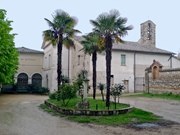
In 1434, St Bernardino of Siena secured the approval of Pope Eugenius IV for the establishment of nine new Observant Franciscan convents, among which was Santa Maria dell’ Oro. He had probably selected this site above Terni during his documented visit to the city in 1426. [Was this the site of a hermitage that had been established a century earlier by Blessed Paolo Trinci?]
Bishop Ludovico Mazzancolli supported the project, but it took some time to secure the necessary financial support from the Commune, so the foundation stone of the new church was not laid until 1441. Tradition has it that St Bernardino stayed in the new convent in 1444, en route for l’ Aquila, where he died.
In 1471, Brother Fortunato Coppoli obtained permission from Pope Sixtus IV to establish a second Observant Franciscan convent in Terni, Santa Maria delle Grazie, because Santa Maria dell’ Oro was already too small and in poor repair. The two convents subsequently maintained a close association.
The original church was in the form of a single nave terminating in a shallow apse. Its facade was moved forward by a bay and its apse was replaced by the present larger structure in ca. 1680. Bishop Sperello Sperelli then re-consecrated the church in 1684.
Santa Maria dell’ Oro was suppressed briefly in 1797 and again in 1812, when the architect Pier Gaetano Possenti took possession of it until the friars were able to return in 1816. It was suppressed again, this time definitively, in 1860.
In 1862 a community of Poor Clares from the Monastero dell' Annunziata and the Monastero di San Procolo (see Franciscan Nunneries) moved here and stayed until 1895.
The church became a parish church in 1910. It was restored in 2000 and elevated to the status of a basilica in 2005.
The convent was used as a school until 1927, when it was adapted as an old people’s home. It is now abandoned and in ruins.
Interior

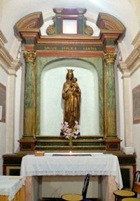
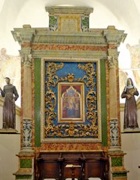
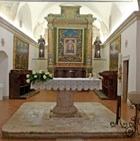
Crucifix (15th century)
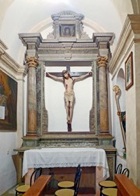
Martyrdom of Gorcum (after 1675)
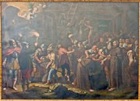
This panel is probably based on one of the prints depicting the scene that were circulated after the beatification. It may have been commissioned after the rebuilding of the apse in ca. 1680. A similar panel from Santa Maria delle Grazie, which seems to have been commissioned by the Nicoletti family, is now in the Pinacoteca Comunale. [I am grateful to Dr. Roy Tepe for sending me much of this information.]
Coronation of the Virgin (1731)

Art from the Church
Triptych (15th century)
This triptych was on the high altar until its replacement (see below) in 1680. Its lateral panels were the dispersed, but its central panel, which is the only known work signed by Paolo da Visso, was retained in the church until ca. 1860.
-
✴This central panel, which depicts the Madonna and Child enthroned, is now in the Musée du Petit Palais, Avignon (illustrated on this webpage); and
-
✴The lateral panels, which depict SS John the Baptist and Bartholomew, are now in the Narodni Museum, Prague.
Mystic marriage of St Catherine (1466)
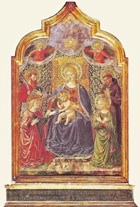
As noted above, this image was highly venerated and normally kept behind a screen, but it was displayed for a short period each year for worship. It was kept in a side chapel until 1680, when Ludovico Rustici arranged for it to be translated to a new wooden structure that he had commissioned in the newly rebuilt presbytery of the church.
The image passed to the Commune when the Poor Clares, who had moved to Santa Maria dell’ Oro in 1862, left in 1895. A dispute with the Rustici family over its ownership was resolved in favour of the Commune in 1899. Documentation at the time of the litigation reveals that the panel was part of a triptych. However, the side panels are no longer known and there is no other surviving record of them.

